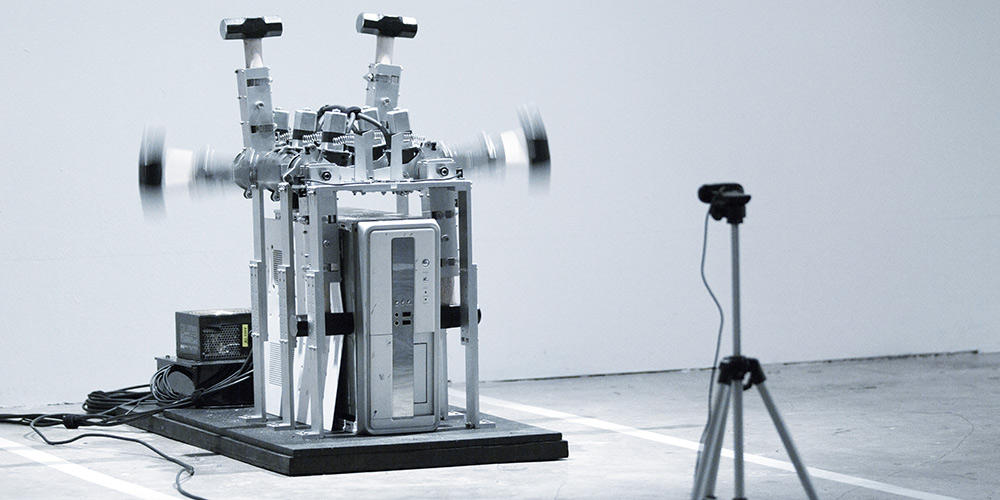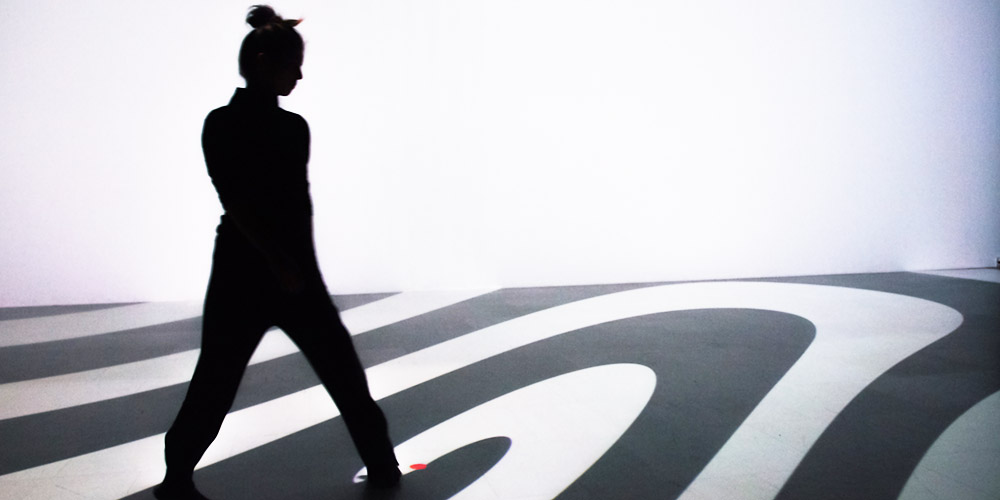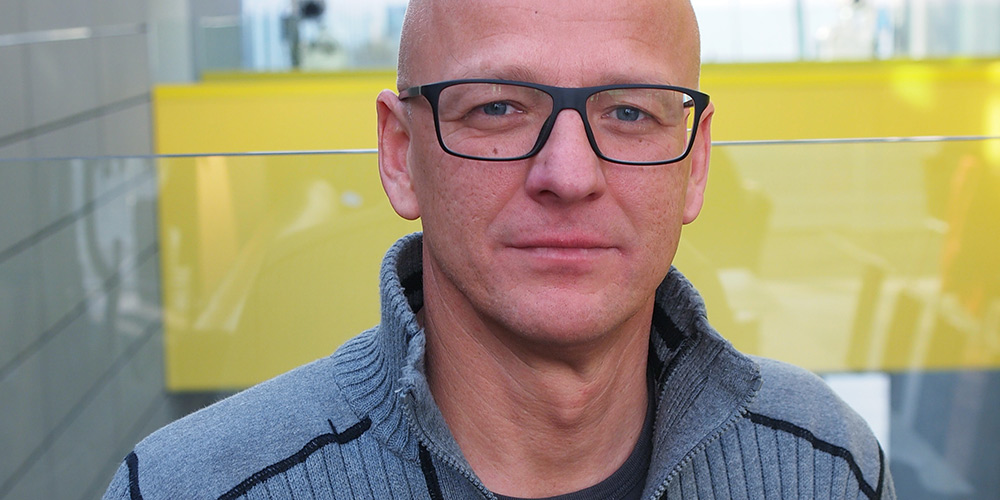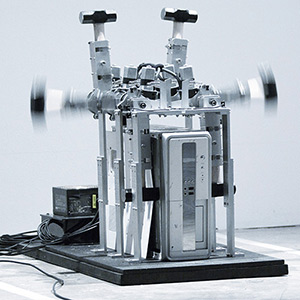“TIME OUT“, this is the title of the new exhibition series at the Ars Electronica Center, which will open on THU January 30, 2014, 7 PM, and will present from now on selected and excellent works of the study course “Time-based and Interactive Media” at the University of Art and Design Linz. Univ.-Prof. Dr. Gerhard Funk, director and founder of the bachelor’s program, explains what we can expect from this study while drinking a cup of tea – and he tells us what we can expect on January 30, 2014, at the Ars Electronica Center.

What does the title “Time-based and Interactive Media” tell us?
The title “Time-based and Interactive Media ” is a very cumbersome title and no one can at least imagine, what does it mean. My short explanation is always following: time-based media are media where time plays an essential design element. Of course, one of them is video, but also audio – always when it comes to design temporal sequences. It also includes installations and performances. And of course we set the focus in our study on the digital. But not only. (He orders green tea) We quite try to produce a hybrid of analog and digital. The term “time-based ” was important for us because not to put too much focus on the area of video. Many come in the hope of being able to join a film class. That’s wrong. Here I always say, there’s Vienna, there is Munich. And then there is the interactive field where it is important that the users have an impact on the timing of the work. And so we are then very clear in the fields of interface design and interaction. And that makes the whole bandwidth – up to the technologies that are so popular nowadays, with a bit of electronics, sensors, actuators, to develop truly tangible interfaces. This is the bandwidth.
We always tell our candidates: You have to like it to take a video camera into your hands, but you also have the will to program or to solder. This is a very broad-based study. At the end of this bachelor’s program you should know for yourself what your own priorities are and in what direction you want to continue to evolve. It is a discovery process that will substantially take place in this study. The trinity is always important: the theoretical discussion of current works of art from this field – but not only. Then the media technology debate, where you will get to know the basics from the beginning. And this shall be reflected as the third pillar of the studies in your own creative artistic actions. We do from the third semester on every semester a larger project. We follow the line that we do not define general topics, but students must find their own topics. That’s part of the process. For me, this is an important difference from a technical college. At a college the technical direction is certainly stronger but our has much more free space for developing your own ideas and for achieving your goals. I have the feeling that it always works better. The study has been around since 2006 and now we have six study years behind us and it has reached a level where we look at the vision from the past and start a redesign of the course.
Currently, the curriculum is very dense. We think about how to reduce this density. But this is a problem of any bachelor’s program in Austria, where you have pressed a lot of things into this study form at the beginning because the claim was to be able to survive in the economy world with a completed Bachelor’s degree. In fact, it is that the least complete after three years, but it is doable even in this time. I am not unhappy about it, because during the last year only a few obligations shall be fulfilled and it is a great freedom that take the students to get deeper into specific areas – and many also finance their studies with working.
This is an attempt to explain this bulky title. The advantage is that those who come to us for the entrance examination have already dealt with the title and its underlying content. The title alone says nothing. And so I am now no longer unhappy about it. We always had about 30 to 40 applications for the entrance examination and about one third is taken. For the study beginning in October 2014, we have two pivotal dates in February and the end of June. The registration period ends on February 14, 2014. (After a quarter of an hour Funk says: “I think the tea already has reached more than three minutes”)
How did the cooperation between the University of Art and Design Linz and Ars Electronica start?
Specifically, this is the first major cooperation with our study program. With the University of Art and Design, and especially with the Master course “Interface Cultures”, the cooperation with Ars Electronica has been around a very long time. At the informal level, there is a very close contact, and I’m still in a very close contact with the Ars Electronica even since the 1990s. The trigger for cooperation on this project was the exhibition “IN TIME” , that we carried out in 2012 on Linz’s Main Square. The abbreviation of our study is “TIME” (Time-based and Interactive Media). Since I have invited the artistic director of Ars Electronica, Gerfried Stocker, I really noticed to my delight that he liked it. At this meeting, in the exhibition, the first ideas came out of how one could create a forum for good students so that they can also show their works at the Ars Electronica Center. That was the starting point. We then set several lines of where the connections between the Ars Electronica Center and our field of study are. One was that I joined the u19 jury – in May 2013. For me this was very important because new contacts were possible.
And now the series we start with the intention for us to show the works of students. I had the impression that this is also interesting for the Ars Electronica Center and fits exactly into the concept. The study course “Interface Cultures” has its fixed exhibition while during the Ars Electronica Festival the great world looks at it. For me it was more the approach to presenting works of our students continuously, when many school groups go through the Ars Electronica Center and discover works they like. Then they might be aware of the study and see that there is already something to study in Linz in this direction. That is why I am very grateful for the regularity. At the end of an academic year, the best works will be selected. We make three appointments in 2014 – in January, May, and then in fall. Here we plan to show two or three works. In the beginning, we just wanted to show only the work of one student, but now we have agreed on a bundle. End of January 2014, we will show four works by two students at the Ars Electronica Center. The desire is that this will be established and our students will have an additional motivating – that’s really something special to be able to show your own work at the Ars Electronica Center and they also agree. On January 30, 2014, 7 PM, we will start.

Could you tell us something about the students and their works?
Stefan Tiefengraber is already an older student, in the sense that he came not fresh from high school but worked professionally in the video field before. He was interested in the width of the study and he has not had a background in the interactive area. He learned very quickly and for me he is the prototypical student who plays with the full range of video, interface design and interaction. And he succeeds very well in developing works with an artistic claim. He wants to make art and succeeds very well. His works are for me very powerful works in reflectivity with the medium itself. He manages to create very beautiful aesthetic objects that stand very well as an object in itself. In “Your Unerasable text” where you can send a text message that is printed and then shreddered immediately. One has the impression that the message is gone, but the title says just the opposite. We all know that this information is not gone. He always plays with these things. In “User Generated Server Destruction” he builds on a long tradition of itself destroying machines. This concept he transmits to the web because the servers are not really present for us. There are huge halls spread all over the world and high security areas filled with servers, but we are not really aware that these machines really exist. Of course, behind every cloud there is hardware. Somewhere, the whole thing needs to get materialized. And if one thinks of the destruction of servers, you can quickly associate hacking and such other things. But hardware exists. Everywhere from the web I can trigger a hammer on a website, and accurately destroy this server to running this site. How many beats are there until the server stops working? For me this is a nice coupling of software and hardware and the awareness that the servers exist. The third contribution takes up the general topic of data visualization where the “Data Distortion Drawing Machine” extracts data from the web and creates aesthetic pictures.
Victor Delev, however, has much know-how of computer science and programming because he has visited the HTL in Leonding. This is evident in his projects. He, too, is a student, who covers a wide range. He has made amazing videos and good interactive works. He is member of a group that has already done stage productions where he performs the visual design with projectors. For him, stage, projection, interaction of the actors with the visual designs are the themes that run throughout his work. His undergraduate work in Deep Space should be developed with a choreographer where the motions will be detected by sensors. The dancer interacts with the reduced black and white projections of Viktor. A very central topic for the Ars Electronica Center. I am a supporter of a reduced design, thus you can concentrate and perceive sharper. But maybe that’s my background, because I have studied mathematics and this plays a role here (Funk tastes his first spoon of tea , “Ah, that fits well”). One must also say, that is not the intersection we show. The two students currently belong to the top. That is clear. I am very pleased with the breadth of the work.

Univ.-Prof. Dr. Gerhard Funk (AT), born in 1958, studied mathematics and art education in Linz and received his PhD in 1989 in theoretical computer science. From the very beginning – since 2006 – he directs the bachelor’s program “Time-based and Interactive Media.”
The opening will take place on THU January 30, 2014, 7 PM, at the Ars Electronica Center Linz. Here, the works of Stefan Tiefengraber and Viktor Delev will be presented, together with Univ.-Prof. Dr. Gerhard Funk, head of the study “Time-based and Interactive Media” of the University of Art and Design Linz and Gerfried Stocker, artistic director of Ars Electronica. The next presentations will take place in May 2014, another appointment is scheduled in autumn 2014.
